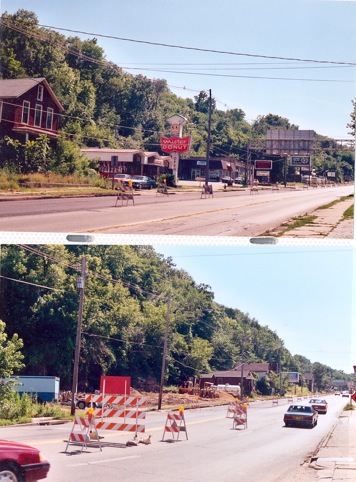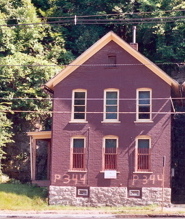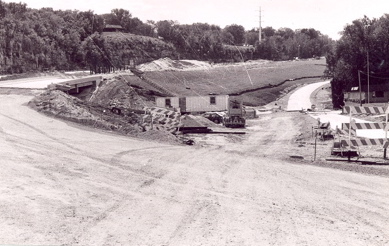Encyclopedia Dubuque
"Encyclopedia Dubuque is the online authority for all things Dubuque, written by the people who know the city best.”
Marshall Cohen—researcher and producer, CNN
Affiliated with the Local History Network of the State Historical Society of Iowa, and the Iowa Museum Association.
HIGHWAY CONSTRUCTION
HIGHWAY CONSTRUCTION. In the early 1970s trucks loaded with equipment from the JOHN DEERE DUBUQUE WORKS had to negotiate city traffic past the DUBUQUE COUNTY COURTHOUSE to reach Dodge Street or highways out of the city. Miles from the interstate highway system started during the Eisenhower administration in Washington, Dubuque was isolated in northeastern Iowa with a threat that economic growth would stagnate.
The DUBUQUE METROPOLITAN AREA TRANSPORTATION STUDY was a major first step in correcting the lack of adequate transportation in and out of Dubuque. The questions remaining were:
1) Where should a major north-south highway be constructed?
2) How should the proposed highway be funded?
The second question was readily answered--federal funding. Additional traffic studies began answering the first question.
Research indicated that 90% of the traffic crossing the MISSISSIPPI RIVER was local--beginning or ending in the metropolitan area. A majority of this traffic had origins or destinations in north of the JULIEN DUBUQUE BRIDGE. The results indicated that constructing a bridge south of Dubuque would not benefit the 17,000 vehicles crossing the Julien Dubuque Bridge.
Construction of a bridge north of the Julien Dubuque Bridge led planners to want a site near the present bridge to relieve traffic. Concerns were also raised as to whether the highway leading to the bridge should be elevated or at ground level and how the intersection of the proposed highway and U.S. 20 would be developed.
The recommendation in 1972 of an elevated freeway design because of the high traffic anticipated led to resistance. City councilmen Robert JUSTMANN, Joseph BITTER, and Mayor Wayne MOLDENHAUER joined others who felt the freeway plan was "over-designed." Residents of the Couler Valley expressway were especially aroused because of the hundreds of homes which were likely to be removed by the right of way/ Concern that the council would vote against the plan led to a historic push by business interests in support of the freeway.
At the September 1972 council meeting only councilman Walter PREGLER was a strong advocate of the expressway. Allan THOMS favored the project to a lesser degree. No agreement could be reached by the other councilmen. Another study was suggested on a route that would align the highway along the railroad and under the Julien Dubuque Bridge. This idea was known at different times as "the Brady plan," "the railroad alternative," or "the Fahey plan." The major attraction of this plan was that it would remove fewer buildings than a freeway through South Locust Street.
The inability of the 1972 city council to reach a conclusion was reflected through the decade. Robert Justmann was especially critical of the extent of the project and the effects it would have on Dubuque neighborhoods. South-end businesses were concerned if the freeway passed nearby. Environmentalists like Richard WORM questioned the need for a highway and bridge and wondered whether mass transit would be more wise. Concern that the freeway corridor came too close to the Dubuque County Courthouse caused planners to move the road to the east. Studies were made of the possible air pollution.
On December 21, 1972, the Iowa Highway Commission approved the new bridge site and route of the highway through Couler Valley and South Locust without formal action from the city council. The proposed route did not come before the city council again until late 1977.
Funding for the project accelerated in the Iowa Senate in 1976 when Richard Norpel, D-Bellevue, introduced a bill for a special appropriation of $5 million for the Dubuque bridge. Bi-partisan local support was quickly shown in the Iowa House when Thomas TAUKE R-Dubuque, and Thomas JOCHUM D-Dubuque, joined their support for the bridge. In June, 1976 Governor Robert Ray approved a state transportation program that included $4 million for major interstate bridges. Allan Thomas, a member of the Iowa Transportation Commission, ensured that the money was directed toward Dubuque.
(to be continued)
Highway construction changed the appearance of Dubuque. The reconstruction of Dodge Street eliminated many dangerous areas and eased transportation flow through the city east and west. The NORTHWEST ARTERIAL allowed trucks and cars to avoid city traffic and encouraged the rapid development of the western city limits.
The reconstruction of Highway 52/151 south included the elevated roadway.




